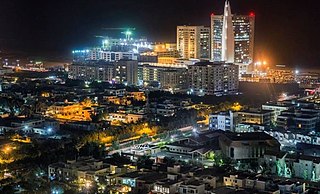
The economy of Pakistan is classified as a low income developing economy. It is the 23rd-largest in terms of GDP based on purchasing power parity (PPP). In 2021, the country had a population of 227 million people. As of FY22, the nominal GDP of Pakistan stands at US$376 billion with a nominal GDP per capita of US$1,658 (177th); its GDP based on PPP stands at US$1.512 trillion with a GDP (PPP) per capita of US$6,662 (168th).

Gadani is a coastal town of Hub District located in the southern part of Balochistan along the Arabian Sea, Pakistan. and is just a 1-hour drive away from Karachi. The population of Gadani was estimated to be around 10,000 in 2005. More than 97% of the population is Muslim with a small Hindu minority. The majority of the population speaks Balochi, Brahui languages and there is a small Lasi speaking minority. They belong to the Sanghur, Kurd, Sajdi, Muhammad Hasni, Gurginari and Bezinjo tribes.
Diamer-Bhasha Dam is a concreted-filled gravity dam, in the preliminary stages of construction, on the River Indus between Kohistan district in Khyber Pakhtunkhwa and Diamer district in Gilgit Baltistan, Pakistan administered Kashmir. Its foundation stone was laid by the then Prime Minister of Pakistan in 1998. The dam site is situated near a place called "Bhasha", hence the name which is 40 km downstream of Chilas town and 315 km from Tarbela Dam. The eight million acre feet (MAF) reservoir with 272-metre height will be the tallest roller compact concrete (RCC) dam in the world.

The energy policy of Pakistan is formulated and determined by the federal, provincial, and local institutional entities in Pakistan, which address the issues of energy production, distribution, and consumption of energy, such as gas mileage and petroleum standards. Energy policy requires the proper legislation, international treaties, subsidies and incentives to investment, guidelines for energy conservation, taxation and other public policy techniques.

The M-5 motorway, also known as Multan–Sukkur Motorway, is a north–south motorway in Pakistan, which connects Multan with Sukkur. The motorway is a 392 km long, high-speed, controlled-access, six-lane motorway that forms part of the China-Pakistan Economic Corridor.
The Nandipur Power Project is a 425 MW combined cycle thermal power plant situated at Nandipur near Gujranwala in the Punjab province of Pakistan. Being constructed by the China Dongfang Electric Corporation, the project was completed in March 2015. The initial cost of the project was Rs. 27 billion, but this escalated during the revised project cycle-1 and totalled Rs. 58.42 bn at completion. The power plant faced a series of hiccups during and after launching its commercial operations. Prior and after construction, the project continued to attract a number of court cases, inquiries, investigations, audits, and political and commercial disputes. The plant collapsed after 5 days of operation, launching a series of inquiries ordered by then prime minister Nawaz Sharif.

China–Pakistan Economic Corridor (CPEC) is a 3000 km Chinese infrastructure network project undertaken in Pakistan. This sea-and-land based corridor is aimed to secure and reduce the passage for China's energy imports from the Middle East by avoiding existing route from the Straits of Malacca between Malaysia and Indonesia, which in case of a war could be blocked and thus hampering the Chinese energy dependent economic avenues. Developing a deep water port at Gwadar in Arabian Sea and a well built road and rail line from this port to Xinjiang Province in western China would be a shortcut for boosting the trade between Europe and China. In Pakistan, its aim is to overcome an electricity shortfall, infrastructural development and modernize transportation networks. Along with shifting it from an agricultural based economic structure to industrial based.

The M-6 motorway, or the Sukkur–Hyderabad motorway, is an under-construction motorway project in Pakistan. It will connect Sukkur to Hyderabad. The 306 km long M-6 motorway is the only missing vital link of North to South connectivity, i.e. from Karachi to Peshawar. The motorway will cost approximately $1.7 billion to build. The M-6 will be a six-lane motorway with a design speed of 120 km/hour, 89 bridges, 15 interchanges and 243 underpasses.
Gulpur Hydropower Plant (GHPP) is an operational run-of-the-river hydroelectric generation project located on Poonch River, a major tributary of Jhelum River near Gulpur in Kotli District of Azad Kashmir, Pakistan. The site is about 167 km from Federal Capital Islamabad and 285 kilometres (177 mi) from Punjab's Provincial Capital Lahore and is approachable directly from Islamabad and Lahore by a two-lane, all-weather, paved, partly mountainous road. The location of the project is about 28 km upstream of Mangla Dam Reservoir.
The Quaid-e-Azam Solar Park is a photovoltaic power station in Bahawalpur, Punjab, Pakistan, named in honor of Quaid-e-Azam Muhammad Ali Jinnah, the Founder of Pakistan. It is a 100 MW solar plant spanning 500 acres (200 ha) and hosting 392,158 solar modules. The initial phase of the project was constructed by the Government of Punjab, Pakistan in May 2015 at a cost of $131 million.
The Sahiwal Coal Power Project is a coal power plant project located in the province of Punjab in Pakistan by the name of Huaneng Shandong Ruyi (Pakistan) Energy (Limited). It has an installed capacity of 1320 MW. It commenced full operations on 3 July 2017.
SK Hydro also known as Suki Kinari HPP, is an under-construction, run-of-the-river hydropower project located on the Kunhar river in the Kaghan valley of Mansehra District Khyber Pakhtunkhwa, which has an installed generation capacity of 874 MW.
The Karot Hydropower Project is an under-construction concrete-core rockfill gravity large dam in Pakistan, with a planned installed capacity of 720 MW. The project is sponsored by Chinese state-owned company China Three Gorges Corporation (CTG).
The Engro Thar Coal Power Project (Thar-ll) is a coal-fired power plant developed as part of the China–Pakistan Economic Corridor by Sindh Engro Coal Mining Company and China Machinery Engineering Corporation in the Thar Block-II of the Thar Coalfield, Tharparkar District, Sindh, Pakistan 25 kilometers from the town of Islamkot near the village of Singharo-Bitra.

The Western Alignment refers to the portions of the China–Pakistan Economic Corridor (CPEC) which are located in the Pakistani provinces of northwestern Punjab, Khyber Pakhtunkhwa and Balochistan.

As part of the China–Pakistan Economic Corridor, reconstruction and upgrade works are underway on the 887-kilometre-long (551 mi) National Highway 35 (N-35), which forms the Pakistani portion of the Karakoram Highway (KKH).
The Pakistan-China Fiber Optic Project is an 820 kilometer long optical fiber cable laid down between the Khunjerab Pass on the China-Pakistan border and the city of Rawalpindi. It has been constructed as part of the China–Pakistan Economic Corridor at an estimated cost of $44 million. Groundbreaking on the project took place on May 19, 2016, in the city of Gilgit. The line was first envisaged in 2009, with Pakistan and China signing an agreement in 2013 to implement the project. However the project was not implemented until being included as part of the China Pakistan Economic Corridor. Placement of the line will take an estimated 2 years, and will bring 3G and 4G connectivity to the Gilgit-Baltistan region.
The first 100 days of Imran Khan's prime ministership began with his swearing-in ceremony on 18 August 2018 as the 22nd Prime Minister of Pakistan – shortly after the oath-taking of the 15th National Assembly of Pakistan on 13 August, and the elected parliament's vote of confidence for Khan's premiership on 17 August. The 100th day of his prime ministership was 25 November 2018.
Punjab Thermal Power Plant is a 1,263 MW RLNG based combined cycle power plant currently under construction. It is located near Trimmu Barrage, District Jhang in the province of Punjab. This is the second RLNG based power project after 1,180 MW Bhikki Power Plant, which is being developed by the Government of Punjab through its own resources. Punjab Thermal Power Private Limited (PTPL), a company wholly owned by Government of Punjab is responsible for establishing and operating the power plant. Power plant has two RLNG based units of 410 MW each, while the third unit is a steam unit which has the capacity of 443 MW. Power plant started simple cycle commercial operations on 4 August 2022 by generating 810 MW of electricity from its two RLNG based gas turbines. Work on the steam turbine is under final stages.
The Bhikki Power Plant is a 1,180 MW RLNG based combined cycle power plant located near Sheikhupura, in the Punjab province of Pakistan. This is the first RLNG based power plant which is developed by Government of Punjab through its own resources. The plant is owned and operated by Quaid-e-Azam Thermal Power Limited (QATPL), a company wholly-owned by the government of Punjab. It is one of the three major RLNG power plants including Haveli Bahadur Shah and Balloki which were built between 2015 and 2018 to curb the electricity loadshedding in Pakistan. Letter of Intent (LOI) was issued on 13 May, 2015 and the project achieved its commercial operations in just 34 months on May 20, 2018.








